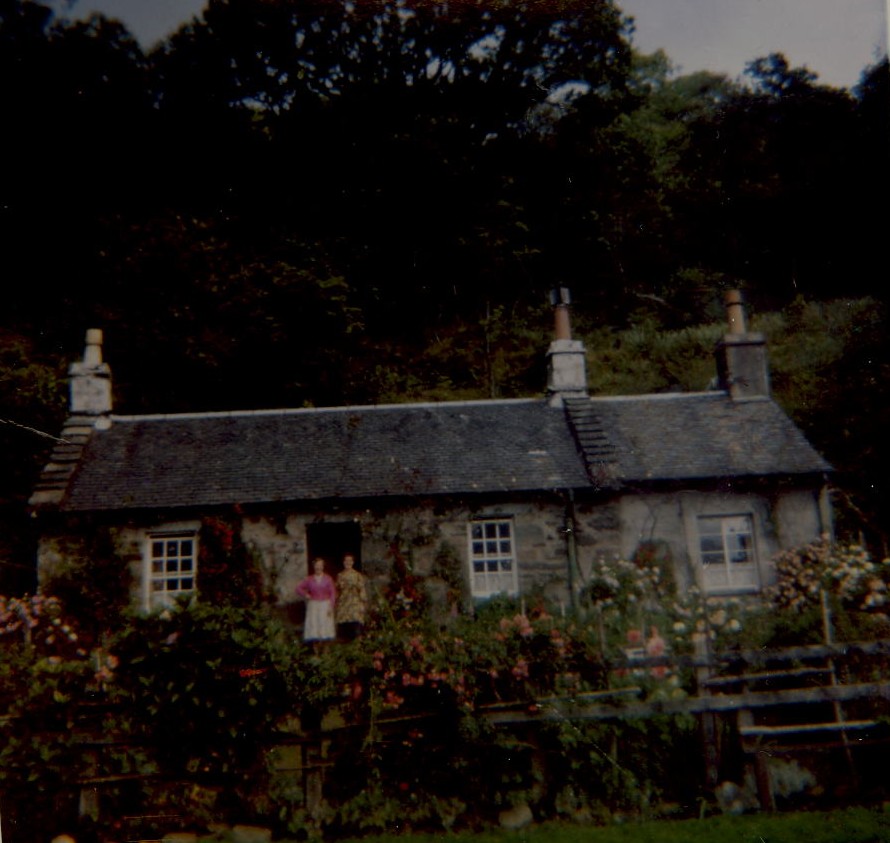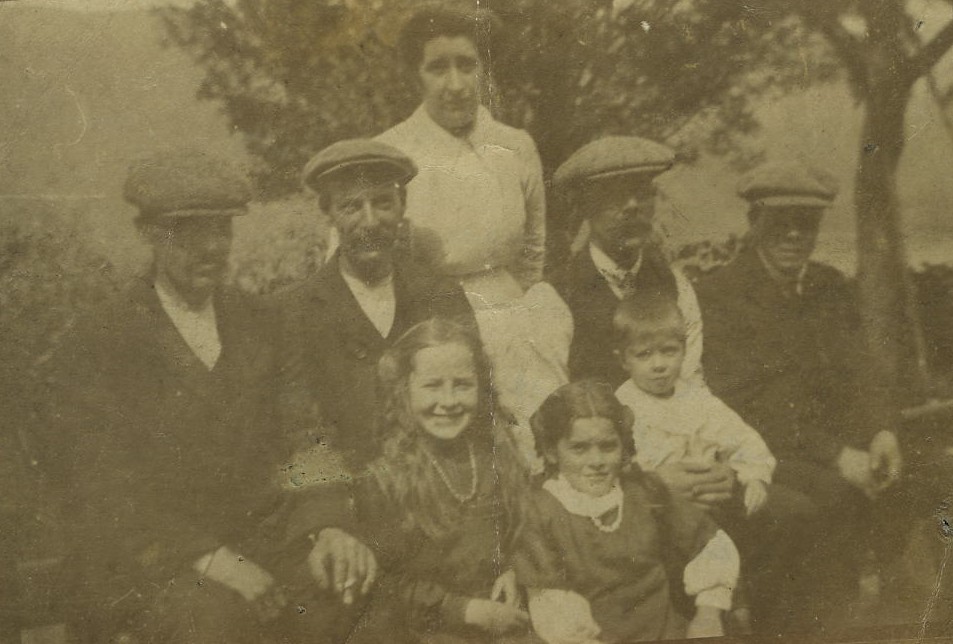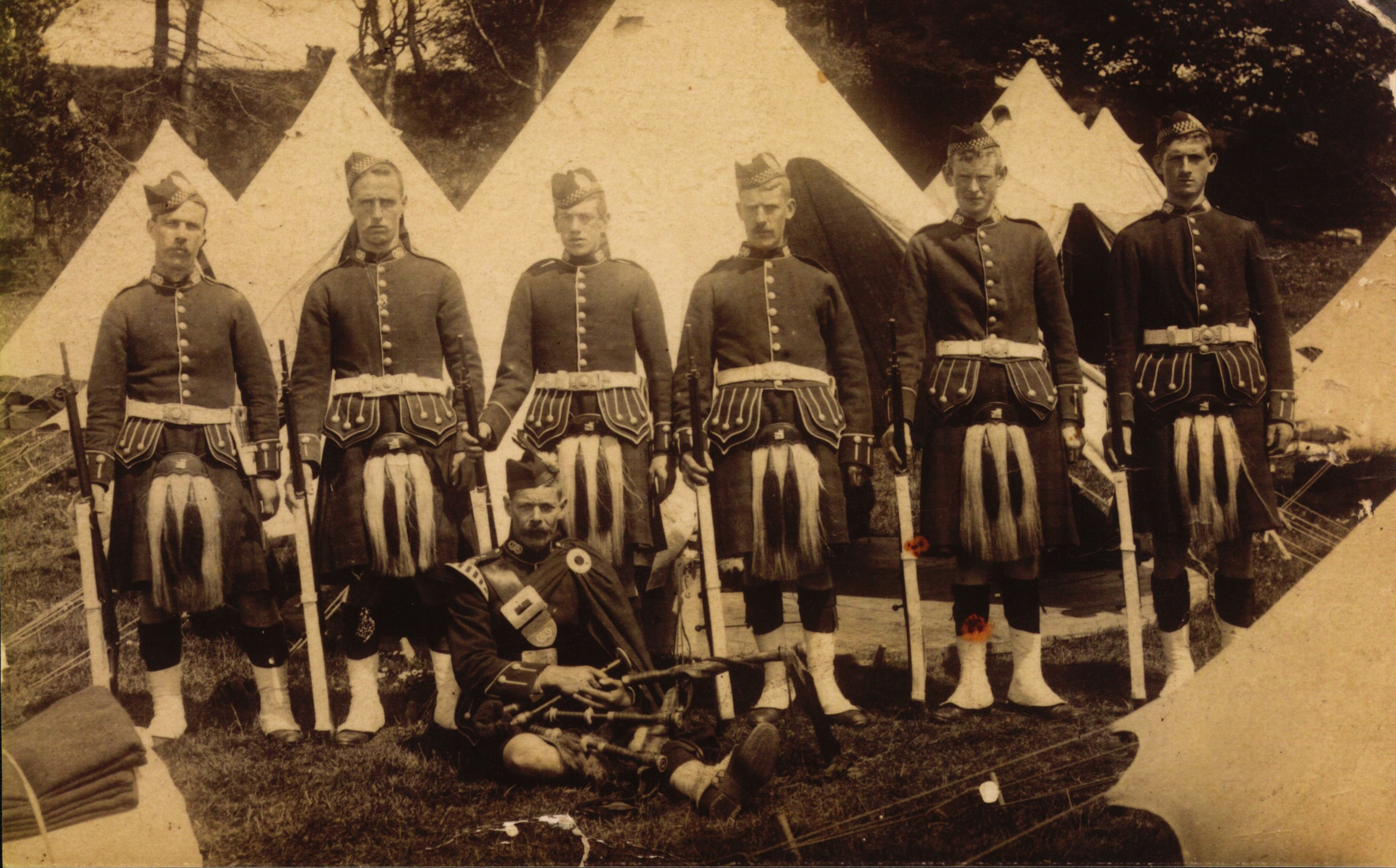Dunderave Cottage | 47 occupants (1841 - 2007)
This is a rustic cottage with modern extension to the east and a modern porch. It is possible the cottage is an 18th century structure which has been remodelled by Robert Lorimer. It is uncertain whether this is a cottage of the mid 18th century which has been worked over by Lorimer, or whether it is all by Lorimer (probably the former.)
The cottage has a low-pitched roof with projecting horizontal eaves and rustic open pediments at the gables. The chimneystacks have been re-built, or coated with cement, with prominent water tables. There are skews of rough stones half lapped and the gable is badly finished with cement. The back right of the building into the hill is snag harled in a Lorimer-ish manner; the front is similar. There are beautiful sash windows and two-leaf front door which is almost certainly by Lorimer. The interior is entirely lined with v-jointed boarding.
The kitchen is probably original with the presence of an original chimneypiece.
Dundarave Cottage
i. General
In summary Dundarave Cottage was originally a single storey, three-bay cottage with a central entrance, its principal frontage facing south to the loch side. Secondary works include the addition of an extension eastwards of a further bay, apparently erected in c.1947; the existing porch was added in the 1980s.
The cottage is approached by a drive to its side to the south-west and here a small turning circle has been formed. Dundarave cottage is occupied by Robert and Liz Petrie.
ii. Exterior
The cottage is of local rubble stone, there is little dressed stone other than the window lintels (see below), and the heavily slabbed copings of the pedimented gables - but again these stones, if they have been fashioned, are still very rough; they appear to be naturally squarish stones. The quoining of the main façades has seen some coarse dressing. This is formed of massive and medium sized blocks of local whin and schist, primarily schist.
The window openings are formed up of rubble stone and the only dressings appear to be the lintels which seem to be of local chlorite schist, a bluey-grey friable schist that is also employed at Inveraray Castle and other earlier estate buildings (from the quarry at St Catherine’s). The lintels of the early windows in the south frontage have been neatly squared but the tooling is coarse with individual droving, with a chisel with a half inch, two thirds inch blade. The sills of the two original windows in the south wall are of roughly formed slabs. The chlorite schist forming the lintels is slightly silvery blue in colour (similar to description earlier). There is a projecting wall footing course and this can be seen at points particularly along the south frontage. The cottage roof is slated. The chimneys appear to be in parts early, surmounting each gable with projecting drip stones formed of coarse, possibly roughly hewn, slabs. The chimneys above have been rendered in cement and may, or may not, be early underneath or have perhaps been rebuilt.
Plate 2 and 3 – West gable and detail of chimney and overhanging eave at west.
The eaves are very deeply overhanging and the pitch of the roof is notably shallow, this governed by the profile of the pedimented gables. This is a particularly unusual form and unique in the Cairndow parish. Clearly there is a little Inveraray classicism creeping in and this building is very prominent on the route from Inveraray to Cairndow, being practically the first building you meet in the Cairndow parish just before you pass Dundarave Castle itself. It may even have functioned as a lodge house for the castle. Clearly some further research into the earlier history of this building would be of great interest.
The porch itself is a secondary addition, apparently added in the 1980s. This appears likely to be of cement block-work but is rendered in cement that has been pigmented and modelled to look like different coloured stonework tones; its appearance is similar to the rubble stone but is clearly modern. This has a slated roof, double pitched. The front door to the porch is of plank and batten construction with vertical boards externally, very simple, with no decorative detail. There is a terrace along the south side of the cottage that is formed of substantial cast concrete paving slabs.
The single bay extension to the east, of 1940s date, is rendered in cement, with a slated roof that is gabled with a chimney at the east end at the apex. This is rendered but flaking shows the brickwork underneath. The cottage extension has a single window in the south side, this has a replacement concrete cill. The cement render on the exterior of this is lined out to look like ashlar. There is a further window in the extension gable wall, offset to the north-east corner.
The early parts of the cottage are pointed up in cement externally. The structure is built hard up against the hillside to the rear and there is quite a gulley along this side. The rear of the cottage appears to contain early, possibly original pointing (on closer inspection this is probably secondary and is fairly hard, looking somewhat cementitious).
iii. Interior
From the main entrance of the cottage one comes through a pair of fine double doors. These are framed, with small glass panels above containing bulls-eye glass (crowns) within, all of which looks relatively early. There is a very fine box lock internally with iron mounts and gothic detailing. It is possible all of this could be of late 19th century or the beginning of the 20th, its Arts and Crafts character possibly suggesting design as one of the estate works by Lorimer himself.
As one enters the main building, the interior is entirely lined out with v-section 3 inch matchboard. One enters into a small vestibule immediately within the entrance area. There is a door on either side and a small door ahead, slightly to the east, to a central room. The doors on either side of the entrance vestibule are plank and batten construction, about 5 inch boards, with a narrow bead and tongue-in-groove joints, with three horizontal battens internally. They are hinged to the north, with a metal box lock - of late Victorian or early 20th century date. The interior is divided by two north/south partitions; it is unclear whether these are early partitions or if this is all part of the later lining-out exercise.
The central room, now used as the kitchen, is very plain, lit by a window in the north wall. The entrance to the kitchen itself has a simple beaded surround, but no door. Internally, at the north end of the east wall of the kitchen, there had been a door which connected to what is now the living room. A small window provides additional borrowed light from the entrance hall and the windows in the front door. The central room contains a modern, fitted kitchen. A hatch in the ceiling of the central room leads up to the loft space, but was not examined.
To the right as one enters, to the east, there is a room, now used as the living room/drawing room. This has a surviving fire surround of pine which is clearly early, but it is unclear whether this is Lorimer period or earlier. The fireplace seems to have once contained a range, suggesting this room had originally been the kitchen. The room is entirely lined out with 3†v-section matchboarding. The ceiling is lined as well, and a very narrow cornice moulding put on. Simple moulded architraves surround the entrances. The sash and case window in this room has chunky glazing bars with a simple chamfer, this seems to be “estate joineryâ€, possibly dating to a later renovation, but not later than mid-20th century. At the north-east corner of the living room there is a door leading into the later extension of 1947. There is a boiler tank boxing at the south-east corner of the living room. This is boarded as the rest of the room, but seems to be later than the general lining of the room, but nevertheless relatively early. This had originally occupied the whole corner but the lower part had been sawn and only the upper part containing the tank with its door is still in place.
The present bedroom to the west is similarly boarded and lined as the other rooms. Sash and case window to the south, again with the simple chamfered glazing bar detailing containing some bullseye glass panes. The window ingo is lined with boarding as well. At the top of the window frame internally there are fittings for a scots blind and a good brass fixing to the lower sash, right side. The room has a fireplace slightly off-set to the north in the west gable wall. This has a modern fire surround of Douglas fir. All of the entrance architraves are of the same moulding detail, this with a narrow quirked angle roll inside and, externally, a cyma moulding beyond. The window in the north side of the central room is a modern, double glazed window.

















